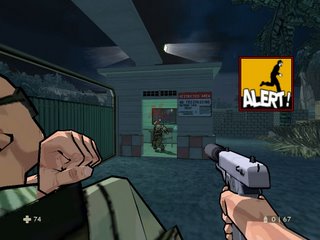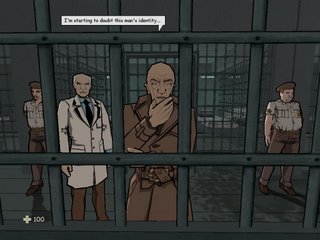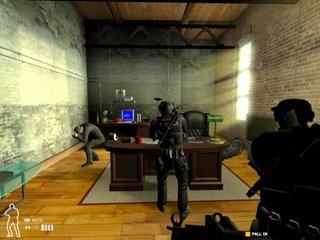Review: XIII (Thirteen)
Website: http://www.xiii-thegame.comXIII (Thirteen) is a first-person shooter based upon a 1980's series of Belgian comics. The plot involves a man who has awoken on a beach, with no recollection of who he is or how he came to his current situation. Throughout the story and game in the role of 'XIII', we discover a dangerous and mysterious government conspiracy. Naturally it's our role to topple the plans and well, save the world - or at least the country.
Screenshots/Demo: http://www.3dgamers.com/games/xiii/ - http://www.3dgamers.com/screenshots/xiii/
Platform: PC CD-ROM, Gamecube, X-Box, PS2
The most noticeable feature of this game is it's cel-shaded graphics. Cel-shading is a method and style in animation/cartooning that has been adopted in the game, admiringly adopting the style of it's comic-book resource. Where XIII may lack in sharp texture detail and bump-maps, it makes up for with it's aesthetically piquing presentation. Noises, words and screams emit from their sources in comic-book fashion with bold lettering. For example, shoot en enemy on the edge of a cliff, he'll plummet down with a stream of "AAAAAAaaaa!!!" following him, shrinking the farther away he falls. Because the game does have audio, you would think such a feature would be redundant - or at the very least, annoying. I didn't find it to be a hinderance, it just further supported the very unique video game world the developers have adapted. Panels will appear within panels during realtime cutscenes, or further-length cutscenes in which there is no player interaction. A rather nice example of this is when you score a headshot on an enemy - 3 small panels pop up in succession in the top-left of the screen, showing the enemy's head like a deer in headlights - then the projectile piercing the head, complete with animated blood. From the comic-book-style execution of enemies and others, you might think XIII is dark-toned game, but truthfully it's more of an adventurous-action fun in the vein of Bond, with a bit of campy humor and nothing too serious.
XIII can pick up various objects to use as melee, such as bottles, broomsticks or even chairs. You can smash people with them - the screen turns blue to signal the knockout factor, as the character groans in pain and slumps to the floor. From there, you can usually pick up the body, carrying it over your shoulder (and wielding a one-handed weapon in your right hand), and hide the body elsewhere. Nice. Weapons are varied and quite fun to see in cel-shaded fashion, and they all translate well. From throwing fists, throwing knives, shotguns, harpoon, semi-autos, grenades and RPGs, even a shard of glass - XIII offers an array of tools to cover your ass. Most weapons feature an alternative-fire mode. The M60 machine gun may fire in auto or burst, the shotgun can be fired or butted against somebody to knock them out, knives can be thrown (unretrievable afterwards) or stabbed/thrust with, and the crossbow can zoom in twice. Items you can carry may be a lockpick, keys, keycards, health kits, and even a grappling hook - which is fun to use, even if it's a bit limited in it's abilities. You can only latch onto particular hooks, not ledges or anything such a hook could support your weight with. This is probably most likely a developmental decision, as having the player grapple his way throughout the game could be compromising to story and experience.
Thankfully, not all of XIII is run-and-gun. Occasionally you will just walk around and avoiding detection, or doing a little weaponless espionage. One particular mission earlier in the game has you going to a bank to retrieve some belongings. Simple and innocent, but naturally something has to go wrong, and from there the story snowballs. Interaction with key characters is interesting to watch. Characters look sharp and distinctual, you start to develop a sense of their mannerisms. Though overall, character development here is lacking. We don't really know the history of your partners or major enemies. Perhaps with such danger in your way and weight on your shoulders, you wouldn't have time to care!
Later in the game the unraveling occurs, and it isn't just via gameplay and cutscenes. XIII's menu offers a few extras to the player. Clicking on Documents, you can read papers you've collected throughout the game. Some you must retrieve, others are optional. Also in the menu is a list of conspirators, who are further revealed and debunked in the list, the more you progress. The developers clearly wanted the player to do a little guesswork and thinking about the story, instead of having it totally revealed - and I think this is a step in the right direction.
Missions and levels vary well throughout and rarely boring. Seeing as you start on a beach, escape from a bank, infiltrate a submarine, scout a wintery log cabin, avoid detection in secret military base, and progress through a shipyard - there should be enough scenic variation to keep you happy. Level design is usually quite well done. Some static objects, such as grates, glass or lumber pieces obstructing an entryway, can be smashed, allowing further (sometimes optional) progression. Even though most levels allow you to backtrack and discover at least 2 routes, there is still a sense of linearity throughout the game. Your actions don't seem to affect a whole lot, or delineate the progression of the story. It's not a big issue, because XIII delivers a memorable and downright fun experience, even if questions are left unanswered - and they will be. XIII covers only the first 5 volumes of the comic, which had a weighty amount of 18 volumes, mostly consisting of 3 issues per. That the game adaption only covers about a quarter of the entire comic may be a dissapointment (especially since there is no announcement of a sequel yet), but don't let it hinder you from purchasing the game.
The game employs a checkpoint save system, there is no quicksave/quickload format here - although the 1.1 patch allows you to quicksave/quickload to the last checkpoint - which kinda baffles me, because if I recall right - it autosaves at each checkpoint regardless. For those of you who can't stand replaying sections of levels, I would say grin and bear it - the game has enough to offer that a repetetive save system shouldn't cripple the experience.
Artificial Intelligence here is nothing outstanding. Reinforcements are called, but most of them just run and gun you with not much regard to their lives. Occasionally they will take cover or root you out, but overall they're just bullet fodder. But wait, theres more! You can also take people hostage. Walk up behind them, hit the action key and you will have them in a choke hold in your left arm, while your right arm may carry a one-handed weapon. By walking backwards towards your intended area, enemies will see that you have a live hostage and (usually) will not fire. A great way to bargain your way out, and save precious ammo. Press the action key again to break the hostage's neck, letting them slump to the floor. Very sleek, very effective. Allies (whether support or escort) usually fend well for themselves, so you don't usually have to worry about keeping the other alive if you're focused on your own defensive obligations - unless that ally has no weapons, then prepare to babysit.
An immersive and mysterious story isn't the entire core of the game. XIII also features multiplayer. You can play on a LAN, Internet or even offline against bots. Multiplayer modes feature: deathmatch, capture-the-flag, team-deathmatch and sabatoge - where teams of 2 or more players with specific skills must defend their given checkpoints from explosion. In addition to a single player game of over 30 missions, and the multiplayer, the developers have included the Unreal Editor, for creating your own levels - further extending the games replayability.
Ubisoft has given fans of espionage and action a well featured and classy game that has made up for it's minor flaws in spades. I can only hope Ubi will release more sequels, completing the XIII saga.
Rating: 4 out of 5
Pros: Intriguing storyline, sharp and stylish graphics, array of fun weapons and methods
Cons: Save system can be discouraging, only 1/4 of the XIII saga is covered leaving you wanting more








